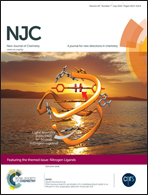pH dependent supramolecular recognition of dapoxyl sodium sulfonate with 2-hydroxypropyl β-cyclodextrin: an application towards food-additive formulation†
Abstract
pH dependent host–guest complexation of dapoxyl sodium sulfonate (DSS), an intramolecular charge transfer dye, with 2-hydroxypropyl beta-cyclodextrin (HP-β-CD) has been investigated. Complexation of DSS with HP-β-CD has been studied at four different pH values using steady-state and time-resolved spectroscopy. Cyclodextrin encapsulation alters the acid–base properties of DSS and results in host-induced deprotonation. A large fluorescence enhancement of DSS was observed upon HP-β-CD binding at different pH values and it enabled us to evaluate the pH dependent binding affinity of DSS with HP-β-CD. The binding affinity of non-protonated DSS was much higher when compared to its protonated state. Subsequently, the encapsulation induced fluorescence enhancement at ca. pH 7.0 has been implemented for developing a fluorescence displacement method for assaying the binding affinity of food-additives namely monosodium glutamate, trans-ferulic acid, p-coumaric acid, gallic acid and its methyl, ethyl and propyl ester derivatives with HP-β-CD. Other than monosodium glutamate, all other tested food-additives show preferential binding to the hydrophobic cavity of HP-β-CD. Therefore, this quick method of assaying the binding affinity of food additives with a water-soluble macrocyclic host molecule can offer better food processing ability, controlled release, and stability.


 Please wait while we load your content...
Please wait while we load your content...